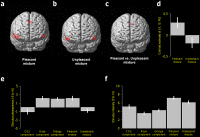Dissociated representations of pleasant and unpleasant olfacto-trigeminal mixtures: an FMRI study
- PMID: 22701631
- PMCID: PMC3373527
- DOI: 10.1371/journal.pone.0038358
Dissociated representations of pleasant and unpleasant olfacto-trigeminal mixtures: an FMRI study
Abstract
How the pleasantness of chemosensory stimuli such as odorants or intranasal trigeminal compounds is processed in the human brain has been the focus of considerable recent interest. Yet, so far, only the unimodal form of this hedonic processing has been explored, and not its bimodal form during crossmodal integration of olfactory and trigeminal stimuli. The main purpose of the present study was to investigate this question. To this end, functional magnetic resonance imaging (fMRI) was used in an experiment comparing brain activation related to a pleasant and a relatively unpleasant olfacto-trigeminal mixture, and to their individual components (CO(2) alone, Orange alone, Rose alone). Results revealed first common neural activity patterns in response to both mixtures in a number of regions: notably the superior temporal gyrus and the caudate nucleus. Common activations were also observed in the insula, although the pleasant mixture activated the right insula whereas the unpleasant mixture activated the left insula. However, specific activations were observed in anterior cingulate gyrus and the ventral tegmental area only during the perception of the pleasant mixture. These findings emphasized for the firs time the involvement of the latter structures in processing of pleasantness during crossmodal integration of chemosensory stimuli.
Conflict of interest statement
Figures

References
-
- Doty RL, Brugger WE, Jurs PC, Orndorff MA, Snyder PJ. Intranasal trigeminal stimulation from odorous volatiles: psychometric responses from anosmic and normal humans. Physiol Behav. 1978;20:185. - PubMed
-
- Cometto-Muniz JE, Cain WS, Abraham MH. Determinants for nasal trigeminal detection of volatile organic compounds. Chem Senses. 2005;30:642. - PubMed
-
- Bensafi M, Frasnelli J, Reden J, Hummel T. The neural representation of odor is modulated by the presence of a trigeminal stimulus during odor encoding. Clin Neurophysiol. 2007;118:701. - PubMed
-
- Frasnelli J, Schuster B, Hummel T. Interactions between olfaction and the trigeminal system: what can be learned from olfactory loss. Cereb Cortex. 2007;17:2275. - PubMed
Publication types
MeSH terms
Substances
LinkOut - more resources
Full Text Sources

